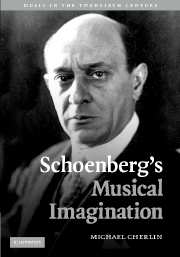Book contents
- Frontmatter
- Contents
- List of music examples and figures
- Acknowledgements
- Introduction
- 1 A passing of worlds: Gurrelieder as Schoenberg's reluctant farewell to the nineteenth century
- 2 Dialectical opposition in Schoenberg's music and thought
- 3 Dramatic conflict in Pelleas und Melisande
- 4 Motive and memory in Schoenberg's First String Quartet
- 5 Uncanny expressions of time in the music of Arnold Schoenberg
- 6 The tone row as the source of dramatic conflict in Moses und Aron
- 7 The String Trio: metaleptic Schoenberg
- Notes
- Bibliography
- General index – names and topics
- Index of Schoenberg's works and writings
4 - Motive and memory in Schoenberg's First String Quartet
Published online by Cambridge University Press: 22 September 2009
- Frontmatter
- Contents
- List of music examples and figures
- Acknowledgements
- Introduction
- 1 A passing of worlds: Gurrelieder as Schoenberg's reluctant farewell to the nineteenth century
- 2 Dialectical opposition in Schoenberg's music and thought
- 3 Dramatic conflict in Pelleas und Melisande
- 4 Motive and memory in Schoenberg's First String Quartet
- 5 Uncanny expressions of time in the music of Arnold Schoenberg
- 6 The tone row as the source of dramatic conflict in Moses und Aron
- 7 The String Trio: metaleptic Schoenberg
- Notes
- Bibliography
- General index – names and topics
- Index of Schoenberg's works and writings
Summary
As would be true of any enduring piece of music, there are multiple ways to think about what matters most in Schoenberg's First Quartet: the genesis of the work's themes as the Quartet unfolds, the ways they form familial relations as well as the conflicts and contrarieties that any family must have; the work's prodigious use of counterpoint, the technical and expressive solutions to problems that lesser composers dare not even attempt; the complex and elusive sense of harmony and voice leading, an aspect of early Schoenberg that after nearly a century still confounds theorists; the question or questions about the work's relations to a larger tradition of string quartet composition; the many different voices that emerge out of Schoenberg's unifying voice, shadows of Beethoven, Schumann, Liszt, Wagner, Brahms, Mahler, and Reger; the place and force of this work in Schoenberg's creative evolution. All of these questions, and more, provide substantial and fertile ways to focus on Schoenberg's Op. 7. Although this chapter will touch on some of these topics, its primary focus is on the work's musical form. Or perhaps I should say, its musical forms, for Op. 7 is not a static, singular object; its formal unfolding is full of wonder and surprise, and surprise precludes and undermines the kind of stasis that the singular “form” seems to indicate.
To state the obvious, Schoenberg's music is grounded, from beginning to end, in the craft and many of the assumptions of his precursors.
- Type
- Chapter
- Information
- Schoenberg's Musical Imagination , pp. 155 - 172Publisher: Cambridge University PressPrint publication year: 2007



